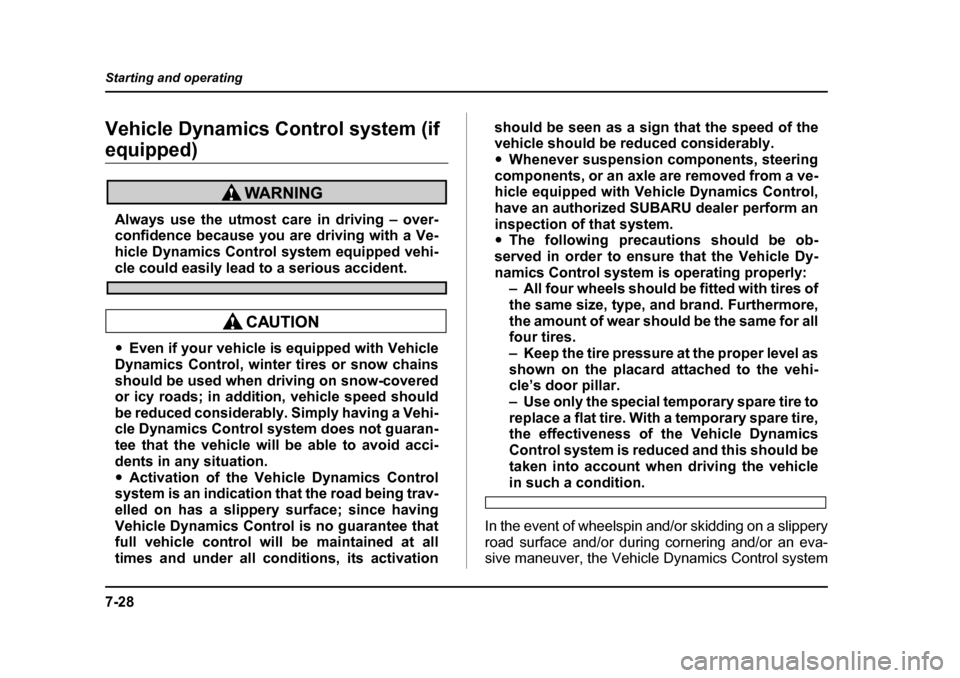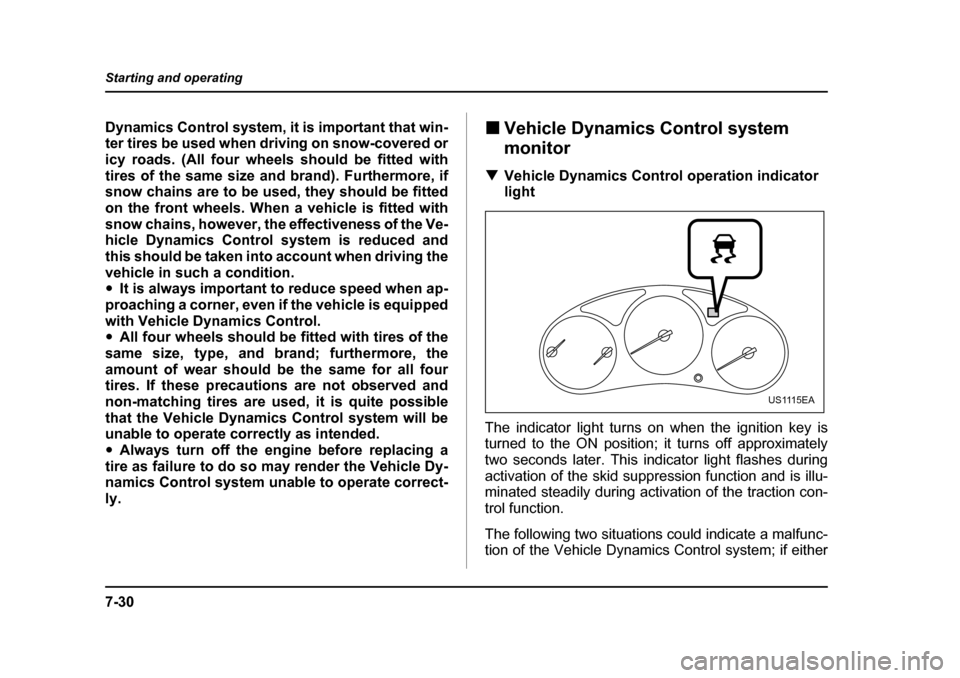2005 SUBARU FORESTER snow chains
[x] Cancel search: snow chainsPage 285 of 477

7-28
Starting and operating
Vehicle Dynamics Control system (if
equipped)
Always use the utmost care in driving – over-
confidence because you are driving with a Ve-
hicle Dynamics Control system equipped vehi-
cle could easily lead to a serious accident.
�y
Even if your vehicle is equipped with Vehicle
Dynamics Control, winter tires or snow chains
should be used when driving on snow-covered
or icy roads; in addition, vehicle speed should
be reduced considerably. Simply having a Vehi-
cle Dynamics Control system does not guaran-
tee that the vehicle will be able to avoid acci-
dents in any situation.�y Activation of the Vehicle Dynamics Control
system is an indication that the road being trav-
elled on has a slippery surface; since having
Vehicle Dynamics Control is no guarantee that
full vehicle control will be maintained at all
times and under all conditions, its activation should be seen as a sign that the speed of the
vehicle should be reduced considerably.�y
Whenever suspension components, steering
components, or an axle are removed from a ve-
hicle equipped with Vehicle Dynamics Control,
have an authorized SUBARU dealer perform an
inspection of that system. �y The following precautions should be ob-
served in order to ensure that the Vehicle Dy-
namics Control system is operating properly: – All four wheels should be fitted with tires of
the same size, type, and brand. Furthermore,
the amount of wear should be the same for all four tires.
– Keep the tire pressure at the proper level as
shown on the placard attached to the vehi-
cle’s door pillar.
– Use only the special temporary spare tire to
replace a flat tire. With a temporary spare tire,
the effectiveness of the Vehicle Dynamics
Control system is reduced and this should be
taken into account when driving the vehicle
in such a condition.
In the event of wheelspin and/or skidding on a slippery
road surface and/or during cornering and/or an eva-
sive maneuver, the Vehicle Dynamics Control system
Page 287 of 477

7-30
Starting and operating
Dynamics Control system, it is important that win-
ter tires be used when driving on snow-covered oricy roads. (All four wheels should be fitted with
tires of the same size and brand). Furthermore, if
snow chains are to be used, they should be fitted
on the front wheels. When a vehicle is fitted with
snow chains, however, the effectiveness of the Ve-
hicle Dynamics Control system is reduced and
this should be taken into account when driving the
vehicle in such a condition. �y
It is always important to reduce speed when ap-
proaching a corner, even if the vehicle is equipped
with Vehicle Dynamics Control. �y All four wheels should be fitted with tires of the
same size, type, and brand; furthermore, the
amount of wear should be the same for all four
tires. If these precautions are not observed and
non-matching tires are used, it is quite possible
that the Vehicle Dynamics Control system will be
unable to operate correctly as intended.�y Always turn off the engine before replacing a
tire as failure to do so may render the Vehicle Dy-
namics Control system unable to operate correct-ly. �„
Vehicle Dynamics Control system monitor
�T Vehicle Dynamics Control operation indicator
light
The indicator light turns on when the ignition key is
turned to the ON position; it turns off approximately
two seconds later. This indicator light flashes during
activation of the skid suppression function and is illu-
minated steadily during activation of the traction con-
trol function.
The following two situations could indicate a malfunc-
tion of the Vehicle Dynamics Control system; if either
US1115EA
Page 302 of 477

8-1
8
Driving tips
New vehicle break-in driving – the first 1,000 miles (1,600 km) .............................. 8-2
Fuel economy hints ...................................... 8-2
Engine exhaust gas (Carbon monoxide) ... 8-3
Catalytic converter ....................................... 8-4
Periodic inspections .................................... 8-5
Driving in foreign countries ......................... 8-6
Driving tips for AWD vehicles ..................... 8-6
Off road driving ............................................ 8-8
Winter driving ............................................... 8-10 Operation during cold weather ........................ 8-10
Driving on snowy and icy roads ...................... 8-11
Corrosion protection ........................................ 8-12
Snow tires .......................................................... 8-13
Tire chains ......................................................... 8-13
Rocking the vehicle .......................................... 8-14
Loading your vehicle ................................... 8-14 Vehicle capacity weight .................................... 8-16
GVWR and GAWR (Gross Vehicle Weight Rating and Gross Axle Weight Rating) ........ 8-16
Roof rail and crossbar (if equipped) ............... 8-17
Trailer hitch (if equipped) ............................ 8-22 Connecting a trailer .......................................... 8-23
When you do not tow a trailer .......................... 8-25
Trailer towing ................................................ 8-25 Warranties and maintenance ........................... 8-25
Maximum load limits ......................................... 8-26
Trailer hitches ................................................... 8-30
Connecting a trailer .......................................... 8-31 Trailer towing tips ............................................. 8-33
Page 308 of 477

8-7
Driving tips
– CONTINUED –
safety purposes as well as to avoid damaging the
AWD system, you should keep the following tips inmind: �yAn AWD vehicle is better able to climb steeper
roads under snowy or slippery conditions than a two
wheel drive vehicle. There is little difference in han-
dling, however, during extremely sharp turns or sud-
den braking. Therefore, when driving down a slope or
turning corners, be sure to reduce your speed and
maintain an ample distance from other vehicles. �y When replacing a tire, make sure you use only the
same size, construction, brand, and load range as the
original tires listed on the tire placard. Using other siz-
es or construction may result in severe mechanical
damage to the drive train of your vehicle and may af-
fect ride, handling, braking, speedometer/odometer
calibration, and clearance between the body and tires.
It also may be dangerous and lead to loss of vehicle
control. �y Always check the cold tire pressure before starting
to drive. The recommended tire pressure is provided
on the tire placard, which is located under the door
latch on the driver’s side.�y Tire chains should always be placed on the front
wheels only.�y There are some precautions that you must observe
when towing your vehicle. For detail information, see the “Towing” section in chapter 9.
�y
Always maintain a safe driving speed accord-
ing to the road and weather conditions in order
to avoid having an accident on a sharp turn,
during sudden braking or under other similar
conditions. �y Always use the utmost care in driving – over-
confidence because you are driving an All-
Wheel Drive vehicle could easily lead to a seri-
ous accident.
Page 311 of 477

8-10
Driving tips
Winter driving �„
Operation during cold weather
Carry some emergency equipment, such as tire
chains, a window scraper, a bag of sand, flares, a
small shovel, and jumper cables.
Check the battery and cables. Cold temperatures re-
duce battery capacity. The battery must be in good
condition to provide enough power for cold winterstarts.
Use an engine oil of proper grade and viscosity for
cold weather. Heavy summer oil will cause harder starting.
Keep the door locks from freezing by squirting them
with deicer or glycerin.
Forcing a frozen door open may damage or separate
the rubber weather strips around the door. If the door
is frozen, use hot water to melt the ice, and afterwards
thoroughly wipe the water away.
Use a windshield washer fluid that contains an anti-
freeze solution. Do not use engine antifreeze or other
substitutes because they may damage the paint of the vehicle. �T
Before driving your vehicle
Before entering the vehicle, remove any snow or ice
from your shoes because that could make the pedals
slippery and dangerous.
While warming up the vehicle before driving, check
that the accelerator pedal, brake pedal, and all other
controls operate smoothly.
Clear away ice and snow that has accumulated under
the fenders to avoid making steering difficult. During
severe winter driving, stop when and where it is safe
to do so and check under the fenders periodically.
HS8004AA
Page 314 of 477

8-13
Driving tips
– CONTINUED –
�„Snow tires
�yWhen replacing original tires with winter
(snow) tires, make sure you use only the same
size, construction and load range as the origi-
nal tires listed on the tire placard. Using other
sizes and construction may affect speedome-
ter/odometer calibration and clearance be-
tween the body and tires. It also may be danger-
ous and lead to loss of vehicle control. �y You must install four winter tires that are of
the same size, construction, brand, and load
range. Mixing other sizes or constructions may
result in severe mechanical damage to the drive
train of your vehicle and may affect ride, han-
dling, braking and speedometer/odometer cali-
bration. It also may be dangerous and lead to
loss of vehicle control. �y Do not use a combination of radial, belted
bias or bias tires since it may cause dangerous
handling characteristics and lead to an acci-
dent.
Your vehicle is equipped with “all season tires” as orig-
inal equipment, which are designed to provide an ad- equate measure of traction, handling and braking per-
formance in year-round driving. In winter, it may be
possible to enhance performance through use of tires
designed specifically for winter driving conditions.
When you choose to install winter tires on your vehi-
cle, be sure to use the correct tire size and type. You
must install four winter tires that are of the same size,
construction, brand and load range and you should
never mix radial, belted bias or bias tires since this
may result in dangerous handling characteristics.
When you choose a tire, make sure that there is
enough clearance between the tire and vehicle body.
Remember to drive with care at all times regardless of
the type of tires on your vehicle. �„
Tire chains
Driving on snowy grades or icy roads may require the
use of tire chains, in which case put the chains on the
front wheels only. Use only SAE class S type chains
that are of the correct size for your tires so as not to
damage the vehicle body or suspension.
When driving with tire chains, drive at speeds below
19 mph (30 km/h).
Always use the utmost care when driving with tire
chains – overconfidence because you are driving with
tire chains could easily lead to a serious accident.
Page 474 of 477

14-7
Index
Snow tires .......................................................... 8-13
Snowy and icy roads ......................................... 8-11
Spark plugs ..................................................... 11-25
Specifications .................................................... 12-2
Speedometer ....................................................... 3-7SRS
Airbag system warning light .......................... 3-13
Frontal airbag ............................................... 1-57
Side airbag ................................................... 1-65
SRS airbags ...................................................... 1-53
Steering wheel
Power ........................................................... 7-21
Tilt wheel ...................................................... 3-39
Storage compartments ........................................ 6-4
Sun visors ............................................................ 6-3
Supplemental Restraint System airbag ............. 1-53
Synthetic leather upholstery .............................. 10-6 T
Tachometer ......................................................... 3-8
Temperature gauge ........................................... 3-10
Tie-down hooks ................................................. 9-13
Tilt steering wheel ............................................. 3-39 Tire
Chains .......................................................... 8-13
Inspection ................................................... 11-43
Pressures and wear .................................... 11-44 Replacement .............................................. 11-48
Rotation ...................................................... 11-48
Types .......................................................... 11-43
Top tether anchorages ...................................... 1-50
Towing ............................................................... 9-13
All wheels on the ground .............................. 9-15
Flat-bed truck ................................................ 9-15
Trailer
Connecting .......................................... 8-23, 8-31
Hitch .................................................... 8-22, 8-30
Towing .......................................................... 8-25
Towing tips ................................................... 8-33
Turn signal indicator lights ................................. 3-21
Turn signal lever ................................................ 3-25 U
Under-floor storage compartment ..................... 6-19 V
Valet mode ........................................................ 2-20
Vanity mirror ........................................................ 6-4
Vehicle capacity weight ..................................... 8-16
Vehicle Dynamics Control ................................. 7-28
Vehicle identification ........................................ 12-10
Ventilator ............................................................. 4-2